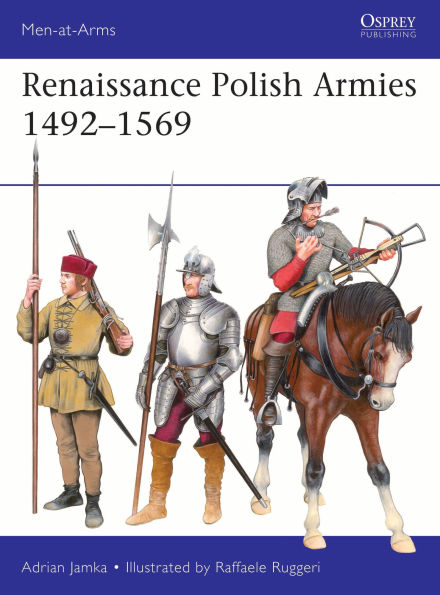This fully illustrated study assesses the armies of Poland-Lithuania at war in the first half of the 16th century, during the transition from feudal to standing forces.
Against a background of almost continual warfare, the 80 years after 1492 witnessed the slow transformation of Polish-Lithuanian forces from feudal levies to standing armies. The bloody struggle between Poles, Lithuanians, Hungarians, Muscovites, Cossacks, Turks and Tatars culminated in the Union of Lublin in 1569, uniting the Kingdom of Poland and the Grand Duchy of Lithuania.
This crucial period in Polish military history saw the introduction and development of famous troop categories such as the Polish hussars, and a tactical transformation with the introduction of foot and mounted hand-gunners to replace crossbowmen. Drawing upon a wealth of sources, the author explains the social and ethnic composition of armies and their methods of recruitment; their organizational structure, and that of units of different troop categories; their weapons, armour and equipment; their strategies and tactics; and campaign life.
In this engaging book, specially commissioned artwork and rare illustrations combine with authoritative text to bring this under-researched subject to life for an English-language audience.
1147282019
Against a background of almost continual warfare, the 80 years after 1492 witnessed the slow transformation of Polish-Lithuanian forces from feudal levies to standing armies. The bloody struggle between Poles, Lithuanians, Hungarians, Muscovites, Cossacks, Turks and Tatars culminated in the Union of Lublin in 1569, uniting the Kingdom of Poland and the Grand Duchy of Lithuania.
This crucial period in Polish military history saw the introduction and development of famous troop categories such as the Polish hussars, and a tactical transformation with the introduction of foot and mounted hand-gunners to replace crossbowmen. Drawing upon a wealth of sources, the author explains the social and ethnic composition of armies and their methods of recruitment; their organizational structure, and that of units of different troop categories; their weapons, armour and equipment; their strategies and tactics; and campaign life.
In this engaging book, specially commissioned artwork and rare illustrations combine with authoritative text to bring this under-researched subject to life for an English-language audience.
Renaissance Polish Armies 1492-1569
This fully illustrated study assesses the armies of Poland-Lithuania at war in the first half of the 16th century, during the transition from feudal to standing forces.
Against a background of almost continual warfare, the 80 years after 1492 witnessed the slow transformation of Polish-Lithuanian forces from feudal levies to standing armies. The bloody struggle between Poles, Lithuanians, Hungarians, Muscovites, Cossacks, Turks and Tatars culminated in the Union of Lublin in 1569, uniting the Kingdom of Poland and the Grand Duchy of Lithuania.
This crucial period in Polish military history saw the introduction and development of famous troop categories such as the Polish hussars, and a tactical transformation with the introduction of foot and mounted hand-gunners to replace crossbowmen. Drawing upon a wealth of sources, the author explains the social and ethnic composition of armies and their methods of recruitment; their organizational structure, and that of units of different troop categories; their weapons, armour and equipment; their strategies and tactics; and campaign life.
In this engaging book, specially commissioned artwork and rare illustrations combine with authoritative text to bring this under-researched subject to life for an English-language audience.
Against a background of almost continual warfare, the 80 years after 1492 witnessed the slow transformation of Polish-Lithuanian forces from feudal levies to standing armies. The bloody struggle between Poles, Lithuanians, Hungarians, Muscovites, Cossacks, Turks and Tatars culminated in the Union of Lublin in 1569, uniting the Kingdom of Poland and the Grand Duchy of Lithuania.
This crucial period in Polish military history saw the introduction and development of famous troop categories such as the Polish hussars, and a tactical transformation with the introduction of foot and mounted hand-gunners to replace crossbowmen. Drawing upon a wealth of sources, the author explains the social and ethnic composition of armies and their methods of recruitment; their organizational structure, and that of units of different troop categories; their weapons, armour and equipment; their strategies and tactics; and campaign life.
In this engaging book, specially commissioned artwork and rare illustrations combine with authoritative text to bring this under-researched subject to life for an English-language audience.
16.0
Pre Order
5
1

Renaissance Polish Armies 1492-1569
48
Renaissance Polish Armies 1492-1569
48Related collections and offers
16.0
Pre Order

Product Details
| ISBN-13: | 9781472867575 |
|---|---|
| Publisher: | Bloomsbury Publishing |
| Publication date: | 03/26/2026 |
| Series: | Men-at-Arms , #568 |
| Sold by: | Barnes & Noble |
| Format: | eBook |
| Pages: | 48 |
About the Author
From the B&N Reads Blog
